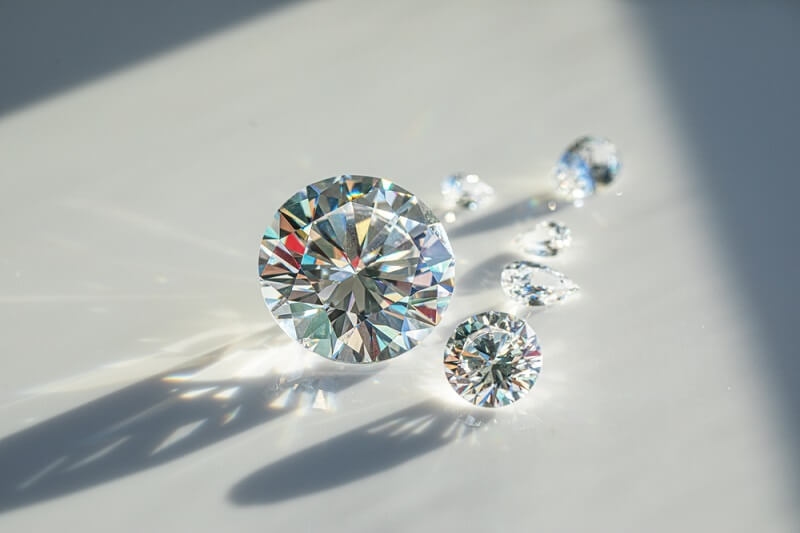Diamond Buying Guide for Smart Shoppers and First-Time Buyer

Acquiring a diamond is not only an emotional but also a financial commitment, so it is helpful to research before making a purchase. This diamond buying guide will help you navigate the confusing world of diamonds with confidence. Whether you are considering how to measure a diamond ring, familiarizing yourself with a diamond clarity chart, or looking at affordable diamond engagement rings, the proper knowledge is empowering. A diamond certification guide can help you verify the authenticity of a diamond. In contrast, "Diamonds Explained" will empower you to learn about GIA-certified diamonds, giving you peace of mind that you are buying a genuine diamond, accurately graded.
Diamonds are not just pretty; they represent slaughters for things, the meaning of love, promises of future togetherness, and timeless elegance. With all the size, shape, and price options available, it is essential to understand the components that determine quality and price before deciding on what to purchase. Now let's get straight to the point.
Why a Diamond Buying Guide Matters
When shopping for a diamond for an engagement ring, you want to combine a beautiful look, authentic quality, and the right price point. But as first-time buyers, it can be confusing when confronted with diamonds and by terms like "cut," "clarity," or "fluorescence." The diamond buying guide will help distinguish these details into practical advice so you can:
- Identify the aspects of a diamond that dictate its value.
- Distinguish the level of marketing versus quality.
- Feel good about choosing a diamond engagement ring that is either a premium or economical alternative without sacrificing brilliance.
- Feel confident in the certification from reputable authorities, by the GIA.
With a clear-to-read guide, you can feel assured knowing that your purchase will become an investment you will cherish for a lifetime.
How to Choose a Diamond Ring
Purchasing a diamond ring is not only a matter of selecting a stone but also involves ensuring that stylistic, quality, and sentimental considerations are addressed. If you are curious about purchasing a diamond ring, here is how to think about it:
- Know the 4 Cs (Cut, Clarity, Color, Carat): These are the universal standards for determining quality and value.
- Choose the Shape: Round, princess, oval, pear, or emerald shapes all differ in how they capture and reflect light.
- Think About Lifestyle: A durable setting may be necessary for more active lifestyles.
- Balance Budget and Brilliance: A somewhat smaller carat weight with an excellent cut will generally appear better than a larger carat weight that is poorly cut.
- Personal Touch: Adding sentimental value can occur through engravings, unique bands, or vintage settings.
Ultimately, your perfect diamond ring represents a combination of personal preference and smart purchasing.
Understanding the Diamond Clarity Chart Explained
Diamond clarity refers to the presence of internal defects (inclusions) or external characteristics (blemishes). A diamond clarity chart helps buyers understand precisely what they are paying for.
The standard diamond clarity grades include
- FL (Flawless): No inclusions or blemishes visible under 10x magnification.
- IF (Internally Flawless): No inclusions, only insignificant blemishes on the surface.
- VVS1, VVS2 (Very, Very Slightly Included): Minute inclusions that are visible under 10x magnification and very difficult to detect with the naked eye.
- VS1, VS2 (Very Slightly Included): Seen under 10x magnification but not with the naked eye.
- SI1, SI2 (Slightly Included): Can be identified under 10x magnification and possibly visible to the naked eye.
- I1, I2, and I3 (Included): Inclusions that are visible under 10x magnification and 100% visible to the naked eye.
Tips for Buyers:
- Pick either VS1 or SI1 for a great compromise between cost and appearance.
- Always view a magnified image of the diamond before purchase.
- Keep in mind that clarity plays a larger role in being rare rather than brilliance. The cut is the most significant factor in sparkle.
The Diamond Certification Guide

Certification guarantees the diamond you purchase is accurately graded. A trustworthy diamond certification reference will make you appreciate the importance of the report.
Why Certification Is Important:
- Verification for authenticity and quality.
- Protection against overpaying.
- Resale or insurance value.
Who Certifies Diamonds?
- GIA (Gemological Institute of America): The most respected certifier, which grades with strict grading methods.
- AGS (American Gem Society): Known for its cut grading.
- IGI (International Gemological Institute): A recognized institute, mainly for retail.
When in doubt, always opt for GIA-certified diamonds, explained in detail, to ensure the quality and assurance of your diamond.
GIA Certified Diamonds Explained
GIA remains the gold standard among all certifiers. Understanding GIA-certified diamonds helps build trust in the purchase for buyers.
Why GIA Is Important:
- An unbiased grading method guarantees accurate grading.
- Every diamond is assigned a specific report number.
- Provides in-depth analysis of cut, color, clarity, and carat weight.
Verification Process:
- The report number can be reviewed on GIA’s official website.
- Verify the old GIA diamond engagement ring with the physical diamond inscription on the girdle.
- Documentation should be consistent with the characteristics of the stone.
A GIA certificate offers invaluable peace of mind in addition to establishing value.
Affordable Diamond Engagement Rings
Many buyers believe that diamonds must be expensive; however, the market offers excellent choices in affordable, high-quality diamond engagement rings.
How to save without sacrificing:
- Choose a slightly lower carat: A 0.9-carat stone looks almost identical to a 1-carat diamond and can save you a bundle.
- Choose lower clarity with eye-clean stones: An SI1 clarity diamond may look eye-clean to the naked eye.
- Look at the other shapes: round is in high demand and can have a premium; consider ovals, pears, or cushions because they tend to be more affordable.
- Use halos: A ring that has a smaller diamond surrounded by accent stones creates the illusion of a larger main stone.
- Consider lab-grown diamonds: Lab-grown diamonds are typically lower in cost and still have brilliance retention while also being certified and authentic.
"Affordable" does not mean someone is compromising on love and meaning; it means they are being wise and informed.
The 4Cs of Diamonds Explained in Depth
A comprehensive guide to purchasing diamonds centers around the 4Cs. Below are some more in-depth descriptions of the 4Cs:
1. Cut
The most important of the 4Cs is cut, which can determine how a diamond shines. An excellent cut will provide the most significant amount of light refraction; a poor cut is dull.
2. Color
Diamonds are identified on a scale ranging from D (no color) to Z (light yellow or brown). The near-colorless stones (G-J) are the diamonds with the best value in terms of both appearance and price.
3. Clarity
I'm really looking into the diamond clarity chart explained earlier; clarity refers to the presence of inclusions or blemishes within the diamond. However, the value comes in the “eye-clean” diamonds.
4. Carat
Carat is the weight of the diamond and not the size of the diamond. Though it is worth noting that the better-cut solid diamonds that are smaller in carat may appear larger than the poorly cut larger carat diamonds.
Diamond Shapes and Their Meanings
Beyond the 4Cs, the shape of your diamond carries symbolism:
- Round Brilliant: Classic, timeless love.
- Princess Cut: Modern, edgy romance.
- Oval: Elegance and individuality.
- Emerald: Sophistication and vintage charm.
- Pear: Uniqueness and boldness.
- Cushion: Romantic, soft brilliance.
Choosing a shape is as emotional as it is aesthetic.
Diamond Settings That Enhance Beauty
The setting holds your diamond securely and enhances its appearance. Popular choices include:
- Solitaire: Timeless simplicity showcasing the stone.
- Halo: Creates a larger appearance with smaller surrounding diamonds.
- Pavé: Band encrusted with diamonds for extra sparkle.
- Bezel: Modern and protective with a sleek metal rim.
- Vintage: Intricate details with classic charm.
Settings impact not only aesthetics but also durability.
Tips for First-Time Diamond Buyers
- Always compare stones side by side.
- Prioritize cut over carat weight for maximum brilliance.
- Request certification before purchase.
- Work with reputable jewelers only.
- Don’t rush—choosing a diamond is a lifelong decision.
Common Myths in Diamond Buying
- Bigger is Always Better: Cut quality matters more.
- All Diamonds Sparkle: Equally, poorly cut stones appear dull.
- Certification is optional: Without it, you risk overpaying.
- Flawless Means Best Value: Often, eye-clean stones offer smarter savings.
Caring for Your Diamond
After buying your diamond, proper care keeps it sparkling:
- Clean regularly with mild soap and warm water.
- Store separately to avoid scratches.
- Get professional cleaning annually.
- Check settings to ensure diamonds remain secure.
Conclusion
This diamond buying guide provides everything you need to make a confident choice. By understanding the 4Cs, reviewing a diamond clarity chart explained, considering affordable diamond engagement rings, and relying on a diamond certification guide, you can make a meaningful purchase. With GIA-certified diamonds explained, your investment carries authenticity, value, and lifelong brilliance.
This content was created by AI

